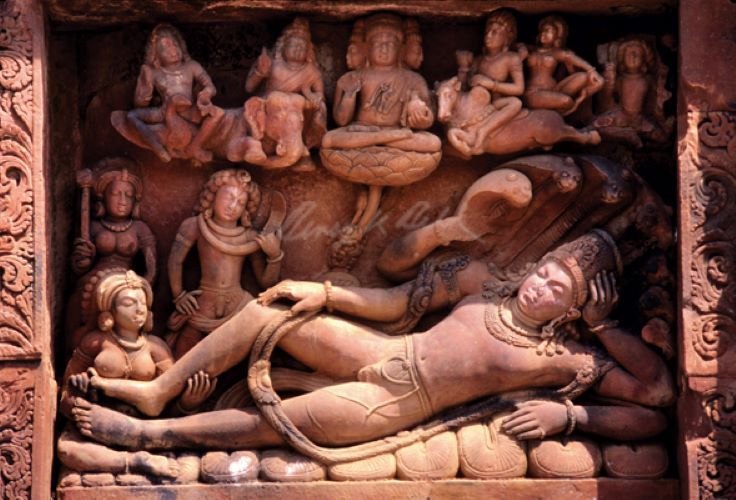Benoy K Behl
Chandragupta-1 founded the Gupta empire in the year 320 AD. His capital was at Pataliputra, in present-day Bihar. He ushered in an age of well-being and prosperity: an age in which all aspects of culture flowered. It was one of the finest periods of mankind, when great thinkers attained noble heights of achievement. The period of Gupta rule, often called a ‘Golden Age’, lasted up to the year 467 AD.
Kalidasa, the greatest Sanskrit poet and playwright, lived during this period. So did the astronomer and mathematician Aryabhatta, the first person to accurately calculate the solar year. Fa Xian, the Chinese pilgrim who visited India at this time, wrote about the liberal rule, light taxes and the well-being and prosperity of the people.
In the 1st century, deities in Indian art had been created in human form. Forms of deities were created to provide a support to minds not prepared to comprehend the formless abstract. These forms were many, all different aspects of the one, formless Truth, Nirguna or Arupa. All paths led to the same goal. The challenge for the artist was to present human forms which did not divert our attention to or bind us to the ephemeral world.
The noble aim for the artist of the Gupta period was to create the human form which rose above itself. It was not the human being who was caught in the web of the material world. It was an embodiment of that which was eternal: that which was still, undisturbed by turmoil and cravings. Meditating upon such a form, devotees awakened the best within themselves. They rose above the pains created by their own desires and confusion.
Indic deities are reflections of the best qualities which are within us: the peace, the joy, the sublime stillness which we can find within us. These deities are aids to our inward journey.
In these sculptures of the Gupta period, the Buddha, or the Enlightened One, personifies an inner calm, in which the noise and confusion of the material world cannot disturb; where the armies of Mara have failed. The only true victory is that over the restless mind, the mind which darts about and will not be still. The mind has been brought to look upon itself and be fully occupied.
Inscriptions state that these sculptures were made beautiful through the science of Chitra, or art- making. It is around this time that the Chitrasutra, the oldest known treatise on art was penned, out of traditions which were ongoing. In Indic art, the emphasis was never on individual problems and their solutions. The best and distilled knowledge of the finest minds was passed down and constantly modified. Canons guided the artist. Individual achievement and works of rare beauty were born out of the immediate experience of the artist of the visualized reality itself.
In the first quarter of the 5th century, 20 rock cut caves were carved out of the hill at Udaigiri, not very far from Sanchi. These are the earliest surviving Hindu temples. The temple was conceived as a home for the deity. We leave behind the mundane world to enter the peace and dark of the interior, for the darshan. Looking upon the deity, who is made to convey the eternal concepts, we awaken the best within us. We are graced by the act of seeing the deity- that is darshan. It is a concept which is central to Indic thought and continues till today.
At Deogarh, near Jhansi in Uttar Pradesh, stands one of the earliest surviving structural Hindu temples. It is dedicated to Vishnu and is dated to about AD 500. On the south face is made the Anantasayana Vishnu, who reclines upon the serpent Sesha, which means Remainder. The serpent is also called Ananta or Endless.
The sublime images of the best of Indic art are created out of devotion and a stillness of the mind. The desire or the ambition to create a great work of art is tempered always by the understanding that this too, after all, is a lila, a dynamic play upon our minds of the world of illusion. The vanity of achievement in creating the art is subdued by a consciousness of a greater reality, in which all this is a passing maya. It is not just the works of art which are ephemeral. The deities too are but a Path towards the Truth. They prepare and bring us a little closer to being able to comprehend the Truth, which is finally of the Oneness of all that there is… it is beyond form.
Under its series Glimpses Of Culture, India Habitat Centre is presenting a talk by Art Historian, Film-maker & Photographer (and the author of this article) Benoy k Behl on October 14, 6pm.
A film Sublime Grace, a film on the art of the Gupta period (produced by Behl for Doordarshan)
will also be screened on the occasion. The event is free. Click here to join the talk online.
Meeting ID: 836 7085 5578, Passcode: 838059
